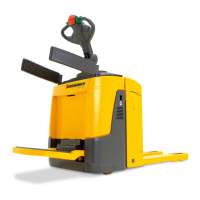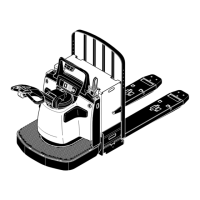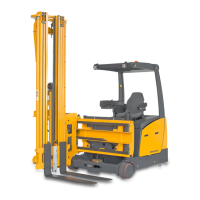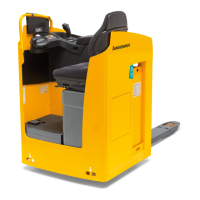Do you have a question about the Jungheinrich EJE C20 and is the answer not in the manual?
General information and purpose of the operating instructions.
Explains the meaning of danger, warning, caution, and note symbols.
Truck must be used as intended; other uses are beyond scope and may cause damage.
Defines correct application parameters including load, distance, and conditions.
Specifies approved operating environments, temperature, and surface conditions.
Defines responsibilities of the operating company and user regarding safe use.
Rules for mounting additional equipment; requires manufacturer permission.
Describes the truck's purpose: transporting goods on level surfaces.
Explains how rated capacity is determined by the truck model.
Defines the truck's travel directions (left, right, drive, load).
Overview of the truck's main assemblies and their functions.
Visual identification of key truck components with numbered labels.
Explains the operational principles of safety, hydraulic, drive, and electrical systems.
Details all technical specifications for the truck's performance and capabilities.
Presents detailed performance metrics like capacity, speeds, and gradeability.
Provides detailed dimensional drawings and measurements of the truck.
Lists the weight specifications for the truck, including axle loads.
Specifies the tyre size, type, and number of wheels for the truck.
Details compliance with EN norms, including sound pressure and EMC.
Defines the environmental conditions under which the truck can be operated.
States the electrical compliance requirements according to EN standards.
Identifies key points on the truck and explains the data plates.
Illustrates and lists the numbered identification points on the truck.
Explains the various items of information found on the truck's data plate.
Details the load-bearing capacity of the truck based on mast lift and load centre.
Explains the effect of wind loads on truck stability and securing loads.
Provides instructions and safety warnings for lifting the truck using a crane.
Details the procedures and warnings for securely transporting the industrial truck.
Guides the initial operation of the truck, including checks and setup procedures.
Covers safety regulations for maintenance personnel and fire protection for batteries.
Details the different battery types supported, including weight and dimensions.
Provides instructions and warnings for safely accessing and removing the battery cover.
Explains procedures and safety warnings related to charging the truck's battery.
Details the process of charging the battery using a stationary charger.
Describes charging procedures using the truck's integrated on-board charger.
Explains how to set charging characteristics for the ELG 2430 on-board charger.
Provides steps for charging the battery with the on-board charger.
Covers the procedures and safety precautions for removing and installing batteries.
Details the process for removing and installing the battery from the top of the truck.
Explains the procedure for lateral battery removal, which is an optional feature.
Covers driver authorization, operator rights, responsibilities, unauthorized use, damage, and repairs.
Identifies and explains the truck's various displays and control elements.
Details the checks and operations needed before starting daily work and switching on the truck.
Lists pre-operation checks including damage, battery connections, and load handler.
Describes how to switch on the truck, including unlocking the emergency disconnect and entering codes.
Covers safe operation, travel routes, work areas, travel conduct, and visibility.
Outlines safety rules for operating in specific areas, loading, and visibility.
Explains the function, CAUTIONs, and procedure for using the emergency disconnect switch.
Details how the automatic braking system functions and safety warnings.
Covers collision hazards, starting the truck, travel control, and anti-roll back device.
Explains how to change the truck's travel direction and associated warnings.
Describes how to switch on and off the slow travel function and related risks.
Explains how to steer the truck using the tiller.
Details the types of braking systems: service brake, regenerative, and parking brake.
Explains how to use the service brake to decelerate and halt the truck.
Describes how regenerative braking works and its benefits for energy recovery.
Explains the automatic application of the parking brake when the truck comes to rest.
Covers safety warnings and procedures for raising and lowering the load handler.
Details the procedure for raising the load handler to the desired lift height.
Provides instructions for safely lowering the load handler to the desired lift height.
Covers safety warnings and procedures for handling loads.
Explains the procedure for safely raising a load onto the pallet.
Provides guidelines for safely transporting loads, including speed and slopes.
Details the procedure for safely depositing a load at the storage location.
Explains the automatic tracking feature for load picking and its operation.
Details how to activate and use the automatic guidance system for lifting and lowering.
Explains the procedure for automatic lifting of the load handler.
Details the procedure for automatic lowering of the load handler.
Lists possible causes and remedies for the truck failing to start.
Provides possible causes and remedies when the load handler cannot lift the load.
Explains how to release and activate the drive wheel brake for manual movement.
Details the procedure for releasing and activating the drive wheel brake.
Explains how automatic braking functions and associated warnings.
Covers collision hazards, starting, travel control, and anti-roll back devices.
Describes the slow travel function, its activation, and deactivation.
How to steer the truck using the tiller.
Explains service brake, regenerative braking, and parking brake.
Procedure for using the service brake to stop the truck.
How regenerative braking works and its benefits.
Automatic parking brake application.
Safety warnings and procedures for raising/lowering the load handler.
Procedure for raising the load handler.
Procedure for lowering the load handler.
Safety and procedures for handling loads.
Procedure for safely raising a load onto the pallet.
Guidelines for safely transporting loads.
Procedure for safely depositing a load.
Explains the automatic tracking feature for load picking.
How to activate and use automatic guidance for lifting/lowering.
Procedure for automatic lifting of the load handler.
Procedure for automatic lowering of the load handler.
Details keypad functionality, code lock, and parameter settings.
Explains how to assign user codes and set the master code.
Steps to prepare the truck for operation using the keypad.
Procedure to switch off the truck using the keypad.
Instructions for changing the master code for access control.
How to add new operator codes to the system.
Procedure for changing existing operator codes.
How to delete specific user codes from the system.
Steps to delete all user codes from the system.
How to set master code length and add new user codes.
Configures the automatic shutdown timeframe for the truck.
How to assign travel programs to user codes via configuration.
Lists and describes settable parameters for travel programs and battery.
Guide to setting truck parameters using the CanCode system.
Guide to setting battery parameters using the CanCode system.
Explains the CanDis display, its indicators, and charge status.
Details the information shown on the 2-inch display unit.
Information on using the ISM Online feature.
Covers general safety and environmental protection during maintenance activities.
Outlines safety regulations for maintenance and repair personnel, including fire hazards.
Details safety precautions when working on the truck's electrical system.
Addresses environmental hazards associated with consumables and used parts.
Warns about accidents resulting from using non-manufacturer-specified wheels.
Covers warnings about brittle and leaky hydraulic hoses causing accidents or injury.
Warns about accidents caused by non-lubricated or incorrectly cleaned lift chains.
Provides guidelines for handling consumables safely and the lubrication schedule.
Details safe handling practices for consumables like oils and greases.
Outlines the lubrication schedule for various parts of the truck.
Lists specific consumables required for the truck, with order numbers and descriptions.
Covers preparations for maintenance, lifting, cleaning, and disassembly.
Details essential safety preparations before starting maintenance or repairs.
Provides instructions and warnings for safely lifting and jacking the truck.
Covers cleaning procedures for the truck and its electrical assemblies.
Details the procedure for cleaning the truck's exterior and interior components.
Explains how to safely clean electrical system components without causing damage.
Provides step-by-step instructions for removing and refitting the front panel.
Details the procedure for disassembling and assembling the drive panel.
Explains how to check and replenish the hydraulic oil level.
Describes the procedure and torque specifications for tightening wheel nuts.
Details how to check and replace electrical fuses, listing their ratings.
Covers final checks and procedures to safely return the truck to service.
Provides instructions for safely taking the industrial truck out of service.
Lists the preparatory steps required before decommissioning the truck.
Details the actions to perform during the decommissioning process.
Covers procedures for returning a decommissioned truck back to service.
Outlines safety tests required periodically and after unusual events.
Covers final decommissioning steps and proper disposal regulations.
Explains the manufacturer's service for measuring human vibration.
Provides a comprehensive checklist for regular maintenance activities.
Lists maintenance tasks for owners under standard equipment categories.
Details maintenance tasks for customer service across various truck systems.
Details maintenance for optional equipment like chargers, aquamatik, and load backrest.
| Brand | Jungheinrich |
|---|---|
| Model | EJE C20 |
| Category | Trucks |
| Language | English |











